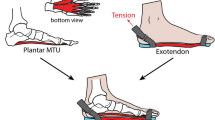Summary
The healthy, well-shaped and elastic foot has become scarce in our stage of civilization due to a variety of reasons. Only the youthful, still elastic and not yet osseous deformed foot is suitable — as far as it is sunken down to the form of a flatfoot position — to be erected to its original physologic position by corrective inner soles.
However, in case the foot sceleton has already adapted itself to its incorrect position, the foot is no more suitable for lifting and therefore corrective inner soles. In this event, an equal dispersion of pressure over the entire foot sole area is to be aspired to, thereby taking advantage of the foot sceleton. This requirement can be achieved by the Euplan inner soles described by Lettermann, which will be adjusted to the foot soles by warming up to a kneadable condition; upon cooling they will keep up the shape of the cast but remain flexible despite hereof.
Furthermore, a stocking with an elastic ring-shaped bandage woven in around the base joints of the toes, is recommended for the support of the enervated cross-arch of the foot.
Both these measures of remedy are saving space and can therefore be worn even in fashionable shoes.
Résumé
Des pieds sains, bien formés et élastiques sont devenus rares à cause de plusieurs raisons à notre époque de civilisation. Seulement le pied juvénile qui est encore élastique et dont les os ne sont pas encore déformés, au cas où il s'agit de pieds plats, peuvent être redressés dans leur forme originale et physiologique par des semelles de redressement.
Mais si le squelette du pied s'est adapté à sa défectuosité, alors des semelles de redressement ne suffisent plus.
En ce cas, on doit obtenir une pression régulière sur la plante des pieds en exploitant le reste d'élasticité du pied et en gardant sa déformation.
Cette exigence est remplie par les semelles de redressement Euplan de Lettermann qui après avoir été chauffées sont modelées sur le dessous du pied et qui en refroidissant gardent l'empreinte et sont malgré tout flexibles.
On recommande pour soutenir le coup de pied fatiqué de porter un bas dans lequel un bandage élastique est tissé à la hauteur de l'articulation des doigts de pied.
Ces deux moyens ne prennent pas beaucoup de place et peuvent être portés même dans les chaussures à la mode.
Similar content being viewed by others
Literatur
Lettermann, A.: Med. Welt (Berl.) (1932).
Bürkle de la Camp, F.: Zbl. Chir. 63, Nr. 16.
Feichtmayer, H.: MMW 98. Jahrg., Nr. 42, DB-Patente 1059374 u. 106397.
Author information
Authors and Affiliations
Additional information
Herrn Professor Dr. Dr. h. c. H. Bürkle de la Camp zum 75. Geburtstag.
Rights and permissions
About this article
Cite this article
Köstler, J. Der ermüdete Fuß. Arch orthop Unfall-Chir 68, 1–3 (1970). https://doi.org/10.1007/BF00418741
Received:
Issue Date:
DOI: https://doi.org/10.1007/BF00418741



